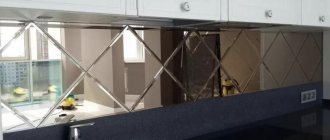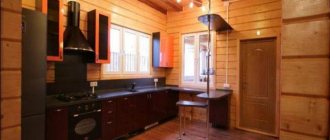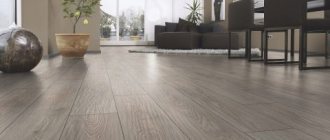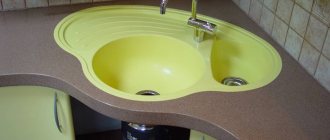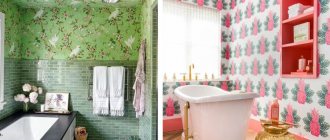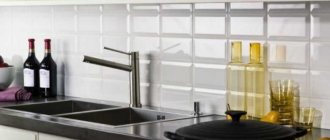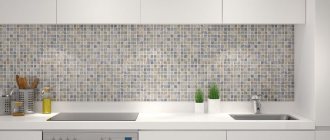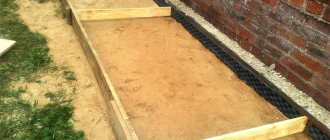Home/Articles/Linoleum for the kitchen: secrets of selection, purchase and installation (33 photos)
Thanks to the optimal price-quality ratio, linoleum occupies a leading position among the variety of floor coverings. Although there was a period of time when this flooring was considered outdated and inferior to other types of flooring, it has recently begun to regain its popularity.
What are the main points you should pay attention to when choosing linoleum for the kitchen?
Linoleum is an environmentally friendly flooring made from natural materials. This wear-resistant coating has a very long service life. Linoleum is resilient and has antibacterial properties, making it a particularly good choice for kitchens.
Four selection criteria will help you learn better about the features of linoleum
Material. Linoleum is made from natural materials including linseed oil, resin, wood flour and pigments.
Since these materials are of natural origin, they are also biodegradable, which is considered a definite advantage when choosing an environmentally friendly coating.
In addition, flaxseed oil is a powerful antiseptic. Thanks to this property, linoleum will protect the floor from harmful bacteria throughout its entire service.
Thickness. The kitchen floor has a purpose rather than a decorative purpose. The appropriate kitchen covering must withstand heavy loads without deforming, remain wear-resistant, and maintain an impeccable appearance.
The thickness of linoleum determines its wear resistance. Especially for kitchens there is linoleum with a thickness of 4-5 mm. This high-performance coating will withstand any intense load.
Coating. Unlike vinyl flooring, the pigments in linoleum run throughout the entire thickness of the material. Any scratches or heavy wear will be the same color as the surface, minimizing visual impact.
Slip. An important feature of linoleum is that, due to its coating, it usually has a rough surface. Therefore, linoleum is popular in places with high humidity.
The fact that this flooring is so easy to clean adds a lot of benefits, but the benefits don't end there.
Artificial linoleum
It is made of polyvinyl chloride and has its own characteristics, but its service life is not long. The coating is available heterogeneous (multilayer) or homogeneous (single-layer).
As for the best linoleum for the kitchen, it is advisable to choose a semi-commercial rather than a household option, since it is less susceptible to deformation due to mechanical influence due to the reliability and thickness of the protective layer.
Which is better – parquet or linoleum?
Linoleum, compared to hardwood flooring, is a less expensive way to achieve a more expensive look for a kitchen floor. One of the remarkable advantages of linoleum is that this material can look like wood, stone or any other floor, which cannot be said about parquet.
Linoleum has a number of useful qualities:
- Elasticity. Linoleum is an elastic flooring material. This means that soft and elastic linoleum provides a more comfortable experience in the kitchen, especially in places where you will have to stand a lot.
- Strength. The characteristics of linoleum make it a durable material. A well-maintained linoleum floor will save money in the long run, outlasting hardwood flooring.
- Moisture resistance. The surface of linoleum has water-repellent properties, therefore, the formation of mold and fungi is excluded. This makes linoleum a good choice for high-moisture areas such as the kitchen.
- Fire properties. Linoleum is not easily burned or melted by dropping hot or burning objects on it.
- Antistatic properties. Thanks to this property, linoleum is easier to clean, since dust will not stick to the floor surface due to static electricity.
- Unpretentiousness. Small cuts and gouges can be repaired using a spare piece of linoleum.
- Environmentally friendly. As stated earlier, linoleum flooring is gentle on the environment and its components are natural.
- Low cost. Compared to parquet, linoleum is much cheaper.
- Easy to install. Laying parquet flooring will require a lot of time, patience and additional leveling of the floor. Linoleum with a thickness of 3 mm does not require preparatory work or special skills.
And finally, parquet cannot boast of such a wide selection of colors, patterns, ornaments and styles, suitable for various designs, for which linoleum is famous.
Linoleum has many positive qualities, but it also has disadvantages:
- Temporary odor. New linoleum has a pronounced odor due to the content of linseed oil. Over time, the smell will disappear.
- Fading and yellowing. With frequent exposure to direct sunlight, the surface of linoleum quickly fades, and in dark places it turns yellow. This is a temporary discoloration that disappears within a few hours of exposure to sunlight.
Advice! A thin linoleum sheet requires a good, level base, otherwise any defects or imperfections will be “transmitted” through its surface.
How to choose linoleum for an apartment
How to lay linoleum on a concrete floor: which linoleum to choose, how to lay linoleum correctly with your own hands, laying technology
The material owes its popularity to a number of characteristics:
- Easy to clean. The coating does not require special care, just wet surface treatment is enough;
- Moisture resistance. Linoleum can be installed in rooms with high humidity - the coating repels moisture and is easy to remove from the floor;
- Easy to install. Often you can lay linoleum yourself;
- Attractive price/quality ratio.
Easy to clean with no extra effort
Laying linoleum with your own hands
The design and compatibility of the material with other interior details is also an important parameter.
Monochrome solutions
Plain linoleum is the most common choice for the design of any room in an apartment.
Which is quite logical, because if you are planning an interior filled with details, then the floor covering should not draw attention to itself
A single-color coating highlights interior elements. Bright floor option
The warm color of plain linoleum visually enlarges the space and creates coziness. Cold tones are used to create a strict interior that is not overloaded with details.
Warm tone "Cold" interior
Color of linoleum and doors
The flooring cannot exist in a design separately from other details. Therefore, the right solution would be to combine the colors of linoleum and doors. The best option would be to create contrast, i.e. if you choose light linoleum, then the door should be darker and vice versa.
Light linoleum and dark doorWhite doors and dark floor
But to avoid disconnection between these elements, the tone of the door or floor covering must be duplicated in the baseboards. For example, a door and a wenge-colored floor plinth go well with gray linoleum.
Combination of wenge and gray tone
What color of linoleum to choose
Linoleum is available in a wide variety of colors and patterns. Even if the desired pattern is not available, the cut pieces can be used to create creative floor designs with stripes and patterns to end up with a unique style.
All this variety of colors and structures allows linoleum to imitate other materials. For example, you can make a kitchen floor that looks like wood or marble when it's actually linoleum.
Such a variety of textures allows you to finish the kitchen floor in any style:
- Plain material is suitable for high-tech, minimalism, techno or modern style.
- Imitation wood will look great in a Provence, vintage, country, eco or any ethnic style interior.
- Linoleum with the texture of ceramic tiles will appeal to those who decide to create a retro, classic or avant-garde style.
- Geometric and abstract designs are suitable for kitchens in the style of pop art, contemporary or futurism.
This material can accept and maintain very deep, rich colors, providing a wide variety of attractive visual effects.
In some cases, you can purchase linoleum that has intricate patterns and motifs on the surface of the material. However, these intricate designs often require installation experience.
The choice of linoleum color is influenced by the following factors:
- A small kitchen will look more spacious if the covering is made in cool colors, imitates small tiles or wooden flooring laid diagonally.
- The color of the linoleum should match the color of the set.
- For a bright kitchen, you should choose a neutral color covering, and for kitchens with a restrained palette, brightly colored linoleum is suitable.
- You can zone a large kitchen using a well-chosen range of linoleum shades in one color spectrum.
- Warm shades will fill the kitchen with coziness, and a monotonous repeating pattern will have a calming effect.
For a low cost, the buyer gets a chic look with minimal maintenance.
Types of linoleum
The material is usually classified according to its field of application, that is, it can be divided into several main groups that correspond to the field of use. Groups are usually designated by two numbers, where the first indicates in which premises it is intended for installation (residential, commercial or industrial), the second number indicates the class of resistance to mechanical loads:
- Household - used in residential premises and corresponds to class 21-23. The 21st is laid in rooms with low traffic - in bedrooms or dressing rooms, the 22nd is suitable for dining rooms or living rooms, and the 23rd is used in the kitchen and corridor - where the load is highest. It is a material consisting of five layers, where the top one not only secures the pattern and texture, but also protects it from damage.
- Semi-commercial - has a protection class from 31 to 34. Designed for warehouses, as well as for kindergartens and clinics. This linoleum is durable and can withstand significant loads, and thanks to the protective film it retains its decorative properties for a long time.
- Industrial - has a very durable coating and belongs to class 41-43. This linoleum is intended for production workshops. It is not used in residential buildings, since its technical and operational characteristics will not be in demand there.
Linoleum is also divided into several types based on the material used - artificial and natural.
Natural
This type of coating is made from natural ingredients:
- Flax oil is the main element that forms the basis of the composition. During oxidation, the substance turns into a dense and rather viscous mass;
- limestone powder - it gives strength to the finished product and belongs to the category of fillers;
- pine resin – provides flexibility to the coating;
- natural dyes – natural pigments that give color to the top layer. Color solutions are not very diverse, but there are both plain and colored or ornamented floor coverings;
- flour from wood or cork is also a filler that gives linoleum ideal smoothness and resistance to ultraviolet radiation;
- jute fibers are the base on which the remaining elements are applied. It is moisture resistant and does not promote the growth of bacteria.
The coating has the following advantages:
- environmental friendliness - this linoleum is made from natural ingredients;
- long service life - from 20 to 40 years;
- resistance to fading of the pattern, as well as to aggressive chemicals;
- excellent performance properties;
- Possibility of use for “warm floor”;
- ease of care;
- immunity to high temperatures;
- non-flammability of coating materials;
- antistatic;
- resistance to the proliferation of pathogenic bacteria.
The disadvantages include the high cost of the product and high requirements for transportation and installation - the material is quite fragile.
There are several types of collections of natural coatings - with marble patterns, with designs in the Renaissance style, reminiscent of a fresco, plain, and also with a textured surface.
Artificial
Synthetic linoleum is resistant to water, it is quite durable and elastic. Unlike natural material, the material has a huge selection of colors - they can be rich and bright or delicate and calm. Also, this linoleum has a varied texture: smooth or rough, matte or glossy. Among other things, modern artificial coatings imitate natural materials - wood, stone or slate. Other benefits include:
- ease of use and low maintenance;
- high-quality PVC coating has good performance properties and is not afraid of mechanical damage or contamination;
- cost savings;
- no need for additional protective compounds that are needed, for example, for parquet boards;
- practically does not change the color saturation;
- has the required level of slip;
- can be used in the interior of any style and design.
Among the disadvantages is that a roll just brought from the store may have a pungent odor, which will certainly dissipate within a few weeks. Also, for high-quality installation, the floor must be absolutely flat, sometimes even a concrete screed is required. Otherwise, in places where there were potholes or cracks, the coating may tear over time.
Preparatory work before installation
Most suppliers offer to install linoleum sheets, but recognize that buyers can do everything themselves.
The surface on which you want to lay linoleum must be smooth, clean, dry, without any impacts, dirt, oil or paint.
When installing, it is recommended to add a deck underlayment. You can use either a cork lining, which helps reduce noise, or plastic, which provides excellent moisture protection.
To lay linoleum you will need the following tools:
- well-sharpened knives for cutting fabric;
- serrated steel spatula (150-200 mm);
- wooden spatula;
- long ruler;
- chalk;
- double-sided tape, mastic or glue;
- optionally – liquid for welding seams.
Linoleum sheets can be installed over an existing floor as long as it is securely attached to the subfloor. If this is not the case, then you need to get rid of it. If plank flooring is installed in the kitchen, then before installing linoleum, the boards are covered with plywood and screwed with self-tapping screws.
Advice! While working on preparing the floor, you should definitely lay out the linoleum somewhere nearby for a couple of days so that the canvas acclimatizes to room temperature. In an insufficiently warmed state, the linoleum sheet is too fragile.
What is linoleum made from?
For the production of linoleum, in accordance with state and international standards, both natural and synthetic materials are used: lime, cork, jute or linen.
The protective, decorative coating is made from PVC - a safe material that can last more than 25-30 years.
For the kitchen, as for living space, it is recommended to use natural, safe linoleum with fire-resistant properties.
Laying linoleum
Laying linoleum is easier and faster than preparing to work with it. There are three methods for installing canvases:
- No glue required.
- Using glue.
- Pasting with mastic.
The first method is the simplest: apply double-sided tape around the perimeter of the sheet and another one at the base. After laying, you need to go over the surface with a wooden spatula to expel the air.
The second method is the most durable: to lay linoleum using glue, you need to bend the sheet to the middle, then apply the glue using a spatula. Before applying the canvas to the floor, you need to hold it in the air, and after laying, squeeze out the air using a smooth spatula. The gluing process is repeated with the second half of the coating.
The third method is too expensive, so it is rarely used at home, more often in commercial enterprises.
What is better to choose for the kitchen: linoleum, tiles or laminate?
Linoleum is often used to decorate a kitchen, but many also prefer tiles or laminate as cladding. Each type of coating has its own advantages and disadvantages.
| Linoleum | Tile or laminate |
| It is durable, depending on the type, it can last more than 15 years. | Laminate boards have a service life of up to 10 years. In addition, laminate and some types of tiles are not impact resistant. |
| Easy to clean using any detergent. | |
| The felt-based covering absorbs noise well. | Some tough stains on laminate flooring are very difficult to remove. |
| It may differ in various imitations, for example, the texture of wood, stone and others. | Tile and laminate are harder and have poor thermal and sound insulation properties. |
| Has a lower price. | |
| This coating is much easier to lay and dismantle. | Easily imitate a wide variety of materials. |
Compared to laminate and tiles, linoleum is a better option for the kitchen.
How much does it cost and where can I buy it?
The cost of linoleum depends on several factors:
- manufacturer country;
- brand name;
- flooring type.
Russian manufacturers offer the simplest linoleum at a cost of 120 rubles per sq. m. m., while the price for foreign goods starts from 300 rubles.
Domestic household linoleum costs from 120 rubles, and foreign from 220 rubles. This type of flooring is designed for light loads. As you know, a low price does not determine the best quality of the material.
Semi-commercial linoleum is much more reliable in quality, which is why it is so valued among buyers. Its price is approximately 300 rubles per sq. m. m.
The next variety is commercial linoleum. A meter of this type of flooring costs from 850 rubles, but it consists of several layers, withstanding a significant load.
Finally, the most expensive material is linoleum made from natural fabrics. The price for this type of flooring is higher than the previous ones - from 1000 rubles.
You can buy linoleum in large construction stores or order from online suppliers.
Criteria for choosing linoleum for tiles
The choice of linoleum for tiles should be made depending on:
- premises;
- the size of the tile shown;
- roll width;
- colors;
- design.
There are three categories of linoleum, depending on the level of load that the material can withstand:
- Domestic. A budget option for rooms with low load. The thickness is on average 1.5 mm. The advantage is the low price, and the disadvantage is low strength.
- Semi-commercial. Is more durable. Suitable for medium terrain. Good thermal insulation and sound insulation characteristics. The cost is slightly higher than that of household ones.
- Commercial. The most expensive option. The material is resistant to chemicals. Used in places with high traffic levels.
Household and semi-commercial are suitable options for durable linoleum for the kitchen
You should pay attention to the markings. There is a European classification in which the wear resistance marking consists of two numbers, indicating, respectively, the type of room and the recommended maximum load level
It is recommended to select a canvas that has such a width that it is possible to lay linoleum in the kitchen using only one roll. This will get rid of seams and joints where moisture can penetrate. If you have to buy two or more rolls, then you need to choose them from the same batch, since shades may differ in different batches. A smell that is too strong should alert you - this may indicate poor quality of the material.
Before purchasing, you should make sure that there is a quality certificate. It is advisable to purchase linoleum from well-known brands whose manufacturers have earned a good reputation. It’s better to start exploring existing options not in the store, but by visiting the relevant websites. It is advisable to visit the forums and read reviews. Before laying linoleum in the kitchen, you should store it in an upright position to prevent deformation.
Top brands
There are several linoleum manufacturers that offer their products through a network of retailers and distributors:
- Forbo (UK);
- ARMSTRONG (UK);
- TARKETT (Germany);
- Sinteros (Russia);
- IVC (Belgium);
- SOMMER (France).
Their products can also be found in several online stores.
When it comes to purchasing high-quality flooring for the kitchen, the deciding factor in this matter, of course, will be durability, environmental friendliness, a large collection of colors and the price of the material. Linoleum fully corresponds to these qualities.
What types of linoleum are there?
Depending on the composition and type of production, linoleum can be natural or polyvinyl chloride. The first option is more expensive, but the quality of the material in this case leaves no reason for worries and dissatisfaction.
The artificial counterpart tries not to be inferior in quality indicators, while caring for such a floor covering is easier, and the price is lower.
There is also liquid linoleum, but it belongs to a separate niche, both price and technological.
When choosing linoleum for the kitchen, always be guided by your desires and common sense.
Linoleum in the kitchen real photos
Laying order
Linoleum - technical characteristics
Immediately before installation, you need to remove debris from the prepared surface with a vacuum cleaner. The debris remaining under the linoleum will eventually lead to its deformation.
It is also important to let the coating rest for 2-3 days in a spread state to avoid creases and unevenness.
- Next, the algorithm of actions is as follows:
- Adjust the canvas to size - cut it to fit the projections of the walls, not forgetting to leave a compensation gap of about 1 cm for laying under the baseboards;
- Thin (baseless) linoleum is laid on glue starting from the wall - the roll is simply rolled out on a surface lubricated with adhesive;
- Thick material is welded at the seam using a special apparatus. Silicone welding does not allow the sheets to separate and prevents dirt from penetrating into the joint;
- The final stage is the installation of plinths. They will press the linoleum to the base and prevent it from “sliding.”
Upon completion of work, the coating should be washed using a cleaning agent.
Linoleum floors in the hallway: nuances you should know when purchasing
As a rule, the manufacturer puts icons on the linoleum, the designation of which is completely unknown to the buyer. And in vain, because they can tell you about the properties of the purchased material.
So:
- Lightning means that linoleum has antistatic properties.
- Wheel - floor covering will withstand the impact of children's and wheelchairs.
- Degree sign - linoleum can be laid on heated floors.
Even if you forget what they mean, you can ask the consultant in the store. Any professional will answer this question.
PVC linoleum
The basis of one- and two-layer polyvinyl chloride (PVC) linoleum is a non-woven thermal insulation or fabric material.
Among the advantages of the coating are:
- affordable price;
- low thermal conductivity;
- environmental cleanliness;
- non-conductivity of current;
- resistance to rotting;
- a rich palette of designs, colors, patterns.
Highlighting the disadvantages, it is worth pointing out the sensitivity of the coating to high temperatures, poor resistance to fats, chemical solvents and alkaline solutions, a sharp decrease in elasticity at low temperatures, leading to cracking.
The variety of products presented on the modern market will allow you to choose plain options or with an original pattern that correspond to individual operating conditions.
Coatings that imitate natural stone, parquet boards, laminate, and tiles are popular.
Which manufacturer to choose?
You should choose a manufacturer wisely. First of all, ask for documentation about the quality of the product, its composition, type of coating and number of layers. A good manufacturer always has with him all the necessary documentation about the quality of the product and conducts checks of his products.
Don’t immediately rush to the lowest price; first check the quality of products from all manufacturers and choose the best one.
We study the types of material
Before you go to the store for new linoleum, you should familiarize yourself in detail with all types of this material and decide exactly which linoleum to choose for the kitchen.
After all, in every store you will be presented with a rich assortment of linoleum, which differs not only in texture and color, but also in other important characteristics.
There are two types of coating - natural and synthetic
Natural linoleum
To be honest, it is the natural material that deserves the proud name “linoleum”, and not its synthetic analogues. Yes, yes, linoleum can be natural.
According to production technology, natural linoleum is an environmentally friendly material and is made from wood resin, linseed oil, cork or wood flour, colored and white natural pigments, and lime powder.
Natural coating is made from wood resin, linseed oil, cork or wood flour, colored and white natural pigments, and lime powder.
The resulting mixture is applied in a thick layer to the fabric and the result is real linoleum. By the way, having a floor made of this high-quality material is no less prestigious than parquet made of expensive wood.
Which linoleum to choose for the kitchen without running into cheap consumer goods? First, study its characteristics.
In addition to the above advantages, natural linoleum:
- easily tolerates chemical compounds and fats;
- antistatic;
- has bactericidal properties;
- does not fade from direct sunlight;
The natural material is absolutely harmless and does not fade from exposure to ultraviolet radiation.
I would like to especially emphasize the fact that natural linoleum does not have harmful impurities and is safe for children.
If you follow all operating rules (of which there are practically none), your linoleum will last about 30-40 years, and at the same time it will have an impeccable appearance!
The cost of natural linoleum will be several times higher than synthetic analogues
It has one significant drawback - the price of such a coating is very high, and many people prefer to buy its cheap synthetic analogues.
With proper care, natural coating can last more than 20 years
Synthetic analogues
If you are still concerned about the question of how to choose linoleum for the kitchen on a limited budget, then you should also consider synthetic analogues.
“Artificial” linoleum is made from polyvinyl chloride, which immediately raises a number of questions about its environmental friendliness and general safety for humans.
Modern models of synthetic linoleum are much more environmentally friendly than their predecessors
But as experts and manufacturers assure, these synthetic materials fully comply with GOST and have a number of European level certificates about their complete harmlessness to the human body. This makes it possible to use such linoleum as a kitchen flooring.
When wondering how to choose the right linoleum for the kitchen, you should know that synthetic linoleum is also divided into homogeneous and heterogeneous.
Synthetic material is divided into homogeneous and heterogeneous
| Type of linoleum | Peculiarities |
| Homogeneous linoleum. This material has a uniform surface and does not have any base, although it is dense and quite durable. You can observe the pattern throughout the entire thickness of the coating, which is ideal for the kitchen and hallway (even with uneven surface wear, abrasions are practically invisible). The main advantage of this material is its rough surface, which completely hides dirt and stains. The average service life of such a floor covering is 5-6 years, but by applying a special protective layer to the surface, the service life can be extended to 10-12 years. | |
| Heterogeneous linoleum. This material has a complex multilayer structure. In construction, such materials are usually called “sandwich” - the coating consists of fiberglass impregnated with PVC paste, a base, a foam layer with a pattern, a chemical or mechanical substrate and a transparent protective layer. |
The thermal conductivity and noise insulation level of the material depend on the quality of the base. The properties of heterogeneous linoleum can also include resistance to mechanical stress and the absence of deformation during operation.
Heterogeneous material is resistant to mechanical damage
Natural linoleum
This type of flooring is made from lime or cork conglomerate in powder form. Resins of wood origin, flax oil and pigments used in coloring are also used. The basis for fixing the mixture is jute or flax fibers.
Natural linoleum for the kitchen is environmentally friendly and can be used for a long period of time (40-45 years). The advantages of the material are:
- resistance to ultraviolet radiation and detergents;
- high wear resistance parameters;
- excellent sound-proofing and heat-insulating properties;
- hygiene and antiseptic qualities;
- poor moisture absorption and low absorption of dirt and grease;
- hypoallergenic.
Natural material is very expensive, so it is most often used in the bedroom or living room. However, if you are planning to decorate an elegant interior, then it will look great in the kitchen.
Durability of linoleum
Durability is an important factor. Easily damaged linoleum will look bad in the kitchen. Running pets, children, adults :-), falling appliances and everything else can damage it, and since linoleum is a solid material, you will have to either change the entire covering or adjust a piece to match the design.
Durable material must also withstand heavy household appliances and household items that are constantly in the kitchen and in the house as a whole.
Classes of linoleum application, digital wear resistance index
The classification of linoleum by wear resistance indicates what mechanical loads the material can withstand during operation. This indicator depends on the thickness of the material.
It is also worth considering the degree of abrasion of the fabric. That is, how quickly the material loses thickness under certain loads. The degree of abrasion is divided into four main groups, namely:
- Group “T” - this includes the most durable types of linoleum that practically do not wear out. Their maximum abrasion thickness can reach a maximum of 0.08mm.
- Group “P” - this includes very low abrasion models, the abrasion thickness of which can reach up to 0.15 mm.
- Group “M” are models of moderate abrasion, where indicators can reach up to 0.3 mm.
- Group “F” - highly abraded types. Usually these are inexpensive models, the abrasion rate of which can reach up to 0.6 mm.
However, please note that wear resistance and abrasion resistance are not the same. For example, canvases from the “T” and “M” groups may have the same characteristics.
When wondering which linoleum to choose for an apartment, experts recommend knowing the classes of their use, as well as the wear resistance designation index, which we will discuss below.
First of all, it is worth noting that our country now uses the European system for determining the class of flooring material - EN 685, which is an index of two numbers.
The first digit represents the type of room and has three options:
- 2 – living quarters, houses, etc.
- 3 – office premises, hospitals, kindergartens, etc.
- 4 – industrial premises, airport, train stations, concert halls, workshops.
The second number characterizes the level of load intensity on the linoleum and includes four options:
- 1 – low intensity.
- 2 – medium intensity.
- 3 – fairly high intensity.
- 4 – extremely high intensity.
Keep in mind that these linoleum grades are recommendations and do not mean that you cannot buy wear-resistant flooring intended for the office. But you need to know that as the class increases by one position, the cost of the material increases accordingly.
The best linoleum for kitchens in different styles
PVC flooring easily transforms a boring interior design. Where such confidence? The biggest advantage of this flooring is that it is available in different designs and colors. So, you can opt for classic single-color models or choose an interesting, original pattern that will enliven the decor of your kitchen, since the possibilities for installing flexible floors are almost limitless.
When it comes to aesthetics, linoleum can fit into any interior. With a "parquet" or "stone" design, they are ideal for kitchens in a classic style. The flooring will become a harmonious backdrop for wooden furniture and muted colors. Lovers of the classics can bet on tiles, and those who like to go crazy when decorating the interior choose colorful linoleum in a fanatical style.
Modern kitchens, in turn, can be decorated using linoleum with a pattern that imitates concrete or the increasingly fashionable terrazzo.
Fans of original solutions and artistic chaos will love patterned, colorful floor coverings, as well as marble models and chessboards.
The stores have linoleum for the kitchen, imitating the patterns of ceramic tiles, terracotta, and porcelain stoneware. Its smooth surface looks noble and stylish, and the large number of available designs allows you to create a stylish interior.
